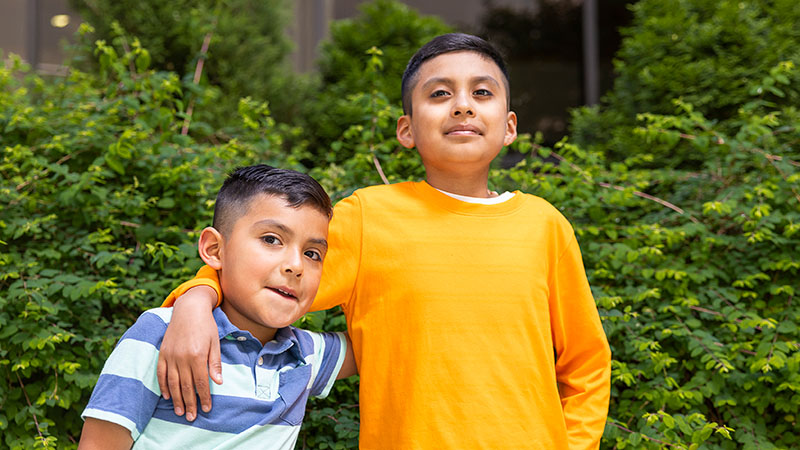Sleepwalking and Sleep Terrors During Childhood
3.25.25 I Heather Cooper
Sleep is a topic that almost every parent has questions about at some point in their child’s life. In the early days, tired parents and caregivers desperately look forward to the time when their baby will begin to sleep through the night. Common questions revolve around sleep training – when can you start, which method should you use, how do you stay patient as you begin a new routine?
Then, in the preschool and elementary school years, some kids experience sleepwalking and sleep terrors. These common sleep disturbances can be very unsettling for parents and caregivers. Dr. Maida Chen, director of Seattle Children’s Pediatric Sleep Disorders Center, answers common questions and shares advice for families dealing with sleepwalking or sleep terrors.
What are sleepwalking and sleep terrors?
 Sleepwalking and sleep terrors are types of sleep issues called parasomnias. Parasomnias are most common from about ages 3 to 10, with most children outgrowing them by the tween years. They typically occur 1 to 3 hours after falling asleep, and last 5 to 40 minutes.
Sleepwalking and sleep terrors are types of sleep issues called parasomnias. Parasomnias are most common from about ages 3 to 10, with most children outgrowing them by the tween years. They typically occur 1 to 3 hours after falling asleep, and last 5 to 40 minutes.
During parasomnias, a child’s brain is asleep, but their body is awake – so they may have their eyes open and talk in a confused way. A sleepwalker will get out of bed and may say and do strange things. A child who’s having a night terror is apt to appear frightened, agitated or even panicked. They may cry out or scream, or just seem dazed as they mumble.
This can be hard to see your child experience, especially considering children having sleep terrors usually avoid being comforted and may even push a parent away. It may provide some comfort to know that your child usually will have no memory of the event the next day, and that these sleep issues are not nightmares. Sleep terrors are not a sign of a traumatic event or psychological problem.
“Night terrors and other parasomnias, which are relatively common in childhood, are nonetheless difficult for any parent to witness. Especially if the parent themselves have been awoken out of sleep from the event!” Chen said. “Remember to stay calm, reassuring, and neutral through the event, and also remember that more aggressive parental intervention can actually make the event last longer.”
What causes sleepwalking and night terrors?
The exact cause of these sleep issues isn’t known, but they often run in families. There are certain things that make it more likely for kids who are prone to these issues to have an episode. These include:
- Not getting enough sleep
- An irregular sleep schedule
- Fever or illness
- Some medicines
- Sleeping with a full bladder
- Sleeping in a different environment
- Sleep in a noisy environment
- Stress
- Family history of parasomnia
- Another primary sleep disorder such as obstructive sleep apnea
What should I do when my child is experiencing a parasomnia?
The most important thing to do is keep your child safe.
- Consider putting a gate at the door of your child’s bedroom and at the top of stairs. An alarm can signal you when your child is up and about and help ensure that they don’t leave the house. Any type of alarm will do, even a simple bell hung on the door.
- Be sure windows do not open wide enough that your child can jump out of them.
- Keep the floor free from clutter so your child doesn’t step on it or trip over it if they are walking during their sleep disturbance.
- Make sure outside doors are locked and secure.
Don’t wake your child up. It can be very difficult to do, and it can actually make them more agitated. It’s natural to want to comfort your child, but remember, they are asleep and if awoken to a panicked parent, they will also be panicked and agitated. It’s best to guide them back to bed if they’re up and not interfere beyond that. Also avoid extensively discussing the incident the next day so that your child doesn’t feel bad or worry; simply asking if they recall anything happening the night before is ok.
Ensure your child is getting the recommended amount of sleep for their age and maintain a regular sleep and wake schedule. Sleep routines can help prevent episodes.
Work as a team with all of your child’s caregivers to have consistency around sleep hygiene and how to handle issues.
Seeking Help for Sleep Issues
Sleepwalking and sleep terrors don’t usually require treatment. However, in some cases another sleep disorder, such as sleep apnea, may be triggering parasomnias, and should be investigated. In severe cases, when these behaviors involve injury, violence or serious disruption to your family, treatment may be necessary. Treatment may include medicine or behavior modification techniques.
Contact your child’s doctor if you have questions or want to get help from a sleep expert. While you wait for your appointment, it’s helpful to keep a sleep diary to document your child’s sleep routine and issues. Share this with your child’s doctor when you have your visit.
“Parasomnias almost always resolve with age with little impact on the child’s growth or development. For most, these become nothing more than funny stories that will be told to children and grandchildren! But they can be stressful on the whole family in the meantime, and seeking help or evaluaton if you have ongoing concerns about your child’s parasomnias is completely appropriate,” Chen reassured.
